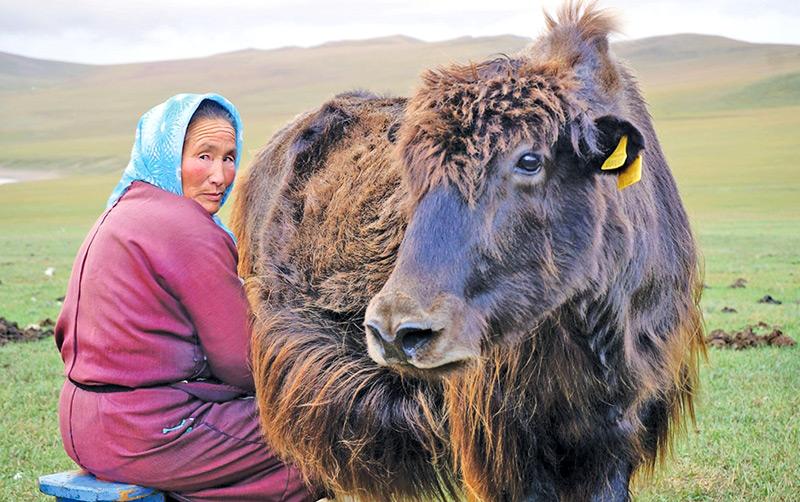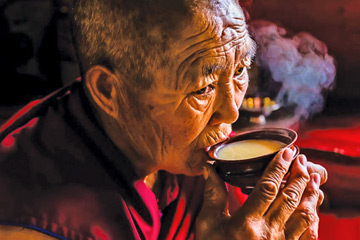
 The dietary patterns of people across the globe are largely influenced by geography, climate, faiths, beliefs, and cultures of the people living in a particular region. Traditional and indigenous diets mainly consist of food prepared using regionally available seasonal crops, lean meat, fish, and egg that best suit the people and the climatic conditions of the area.
The dietary patterns of people across the globe are largely influenced by geography, climate, faiths, beliefs, and cultures of the people living in a particular region. Traditional and indigenous diets mainly consist of food prepared using regionally available seasonal crops, lean meat, fish, and egg that best suit the people and the climatic conditions of the area.
For instance, people living in mountainous areas under extreme cold weather tend to incorporate more animal-based foods such as red meat than plant-based ones. The reason is that plant-based food alone cannot provide them the energy required to resist the cold weather. Red meat and other animal-based food rich in protein become their staple diet. Moreover, agriculture is limited in such areas.
Tibetan diet
For example, the diet of indigenous Tibetans consists largely of home-produced meat, dairy products, and cereal grains such as barley. The consumption of rice is restricted in comparison to other South Asian countries. Low consumption of vegetables and fruits is also notable. Yak meat, barley, dri (female bovine) milk, and dairy products which are the main components of the traditional Tibetan diet provide calories, other vital nutrients, and healthy fat to survive in the cold highland.
Tibet which is also known as the ‘land of snow’ is at an elevation of around 16,500 feet from sea level and has a cold, dry climate. Tibetan plateau is one of the highest inhabited regions in the world. Barley is widely grown due to the adaptability of the crop. Tsampa (Tsamba) is the staple food of Tibetans. Since Tsampa is intertwined with their culture and tradition, the people of Tibet are also known as Tsampa-eaters.
Whole grain barley
Tsampa is prepared using whole grain barley flour. It is highly nutritious and easy to prepare. Whole grain barley is roasted and ground to obtain a fine powder. Butter tea, the national drink of Tibet which is known as Bojha in the Tibetan language is then added to the ground whole barley powder and rolled with hand. Apart from butter tea, yak butter and yak cheese are also added when preparing Tsampa.
 Barley is rich in soluble fibre. Studies have found that barley has more fibre content than oats which is a popular grain in the West. Barley contains beta-glucan fibre that is known to lower blood cholesterol. Barley is also a good source of several vitamins such as vitamins B, E, and minerals such as iron, zinc, copper, and magnesium. It has a low glycemic index and consumption does not contribute to the rise of insulin in the blood. That too helps keep healthy body weight. Whole grains promote digestive health and cure constipation due to their high fibre content. Studies have found that whole grains such as barley can inhibit colon cancer. Whole grain barley also lowers cholesterol.
Barley is rich in soluble fibre. Studies have found that barley has more fibre content than oats which is a popular grain in the West. Barley contains beta-glucan fibre that is known to lower blood cholesterol. Barley is also a good source of several vitamins such as vitamins B, E, and minerals such as iron, zinc, copper, and magnesium. It has a low glycemic index and consumption does not contribute to the rise of insulin in the blood. That too helps keep healthy body weight. Whole grains promote digestive health and cure constipation due to their high fibre content. Studies have found that whole grains such as barley can inhibit colon cancer. Whole grain barley also lowers cholesterol.
Hence, eating Tsampa as a staple not only provides them the vital nutrients and energy to survive in the cold but also helps them live a healthy life. Common non-communicable diseases such as diabetes, cholesterol, high blood pressure, or cancer are uncommon among the indigenous Tsampa-eaters. They are hardly malnourished, and obese traditional Tibetans are hard to find.
Yak meat and dri dairy produce
Yaks are the predominant animals living in the high-altitude region. Yaks are long-haired ox-like mammals. Their bodies are heavily fringed with hair, and a shorter undercoat helps them keep warm.
Yak meat is frequently consumed by these highlanders to keep their bodies unaffected by the frigid winter temperature of Tibet. Both raw and dried yak meat is consumed. Grass-fed yak meat is rich in protein, vitamin B, iron, zinc, Omega-3 fatty acid,and other vital nutrients. In comparison to other red meat, yak meat is said to have a lower fat content. Compared to beef, yak meat has one-sixth of fat and 40 percent more protein. The meat of this animal living in a frigid climate is said to be low in unhealthy palmitic acid.
 Research scientists at the National Research Centre on Yak (NRCY) in India have found that grass-fed yak meat keeps the cholesterol level under control. Scientists have found that cardiac diseases are rare among those who regularly consume yak meat.
Research scientists at the National Research Centre on Yak (NRCY) in India have found that grass-fed yak meat keeps the cholesterol level under control. Scientists have found that cardiac diseases are rare among those who regularly consume yak meat.
Yak meat is a sustainable alternative to beef and most of other red meat.
Dri milk, and dairy products such as dri butter, dri cheese, dri yoghurt, and dri butter milk are included in their daily diet apart from yak meat. As per a report issued by the Food and Agriculture Organization of the United Nations (FAO), dri milk has 15-18 percent of solid content and 4-5.9 percent of protein. Hence, dri milk has a higher solid, protein, and fat content than cow’s milk or goat milk. Dri dairy products are rich in calcium and omega-3 fatty acids.
Butter tea (Bo-jha/ Po-cha, Bo-cha) has a significant place in the Tibetan traditional diet. Bojha is prepared using fermented tea leaves, Himalayan rock salt, dri butter, and dri milk. Although the traditional way of preparing Bojha may consume time and energy, a cup of butter tea can be prepared in a couple of minutes using modern utensils.
For preparing Bojha, fermented tea leaves (Pu-erh) are used. The fermented tea is rich in antioxidants and healthy phytochemicals (chemicals found in plants). They introduce good probiotics to the body. Studies have shown that fermented tea leaves help lower cholesterol and can inhibit some cancers.
When making traditional Bojha, the fermented tea leaves are allowed to steep in simmering water for many hours. Once the tea is brewed, water is strained and poured into a traditional churn (Changdong) along with a good amount of Himalayan rock salt, dri butter, and dri milk. This mix is churned about ten times and served warm. This high-calorie butter tea keeps their bodies warm in the harsh cold weather. It is a norm to sip three to four cups of warm butter tea a day.
Pink salt
Tibetans consume a comparably high amount of salt in a day. Since they do not have access to sea salt, they use Himalayan rock salt known as pink salt. This salt is believed to be healthier than its sea counterpart. Since the sodium content of pink salt is lower than the regular table salt, damage to health is lower. Research has claimed that unlike sea salt, rock salts do not cause hypertension.
Studies have found that pink salt helps ease respiratory diseases and balance the body’s pH level. Rock salt is admired by nutritionists across the globe for its ability to regulate blood sugar levels. While improving sleep quality, pinks salt is also believed to increase libido.
Legend has it that the deposits of a prehistoric lagoon in the foothills of Himalaya many million years ago have converted to a salt mine in the region.
Fruits and vegetables
Since the frequency of eating fruits, vegetables and nuts are considerably low (perhaps 2 or 3 times a month), there may be a nutritional imbalance in the indigenous Tibetan pastoralists who have adopted the traditional diet. Variety is hardly seen in the geographically and culturally influenced monotonous dietary pattern of these highlanders.
Nevertheless, food made of yak meat, dri milk, dri dairy products, and roasted barley flour provide them the recommended daily dietary allowance of some vitamins, iron, zinc, protein, minerals, carbohydrates, and healthy fat. Eating fewer vegetables, fruits, and nuts may deprive them of some vitamins, yet the impact may be trivial.
People living in higher altitudes tend to consume more meat and dairy than those of the lower regions to enable them to survive under harsh climatic conditions.
On the contrary, people of the tropics generally incorporate more fruits, vegetables, grains, and nuts. Red meat, poultry, and egg are also a part of their diet but not regular. Tropical countries have hot and humid weather which is favourable for the growth of a vast array of flora. Hence, naturally, there is a high intake of plant-based food when the produce is abundant.
Change of food pattern
However, the food pattern of the Tibetan indigenous pastoralists has had a drastic change due to the resettlement of the community in urban and semi-urban areas. This has many pros and cons. With urbanisation, more fruits, vegetables, and nuts became accessible to the indigenous highlanders. This has helped them have a high diversity in their diet.
On the contrary, the decrease in the consumption of yak meat, dri dairy products, and Tsmapa is not welcome. The traditional and indigenous culinary skills of preparing home-produced dri dairy products have not been passed on to the present generation, so the members of the younger generation are more prone to consume western-style food. The abundance of western foods such as sugary drinks, confectionaries, and snacks laden with chemicals, oil, and salt has substantially impacted their health.
A recent survey suggests a prevalence of obesity among settled pastoralists. The number may rise in the future if they totally shed their indigenous dietary patterns and adopt a western-style diet. The change in the dietary patterns may give rise to non-communicable diseases too.
(Dr. Naveen De Soysa is the Assistant Secretary of the Government Medical Officers’ Association and the Registrar in Community Medicine at the National Institute of Health Sciences. Panchamee Hewavissenti is a culinary researcher and recipe creator)
